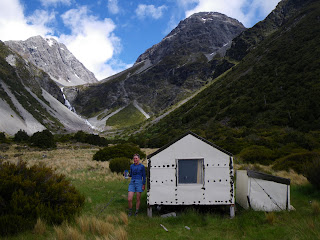
Samuel Butler, a 19th century novelist and aristocrat, had spent time as a young man in New Zealand. Indeed Butler Saddle had been named after him as he'd worked a sheep station in the valley of the Lawrence and Clyde Rivers.
In his most famous novel, published anonymously as Over the Range, he wrote satire on Victorian England, a ficticious place called "Erewhon", sort of like "nowhere" backwards. Our destination, the mega-sized sheep, cattle, horse, and deer farm called "Erwehon Station", was named from that novel.
Erwehon Station in many ways represents well that inter-digitation of NZ's domestic and wild. It's where the mountains meet the lowlands, where wind and weather still rule but humans work hard to profit.
Nearby Erwehon Station we would learn is a popular tourist destination, Mount Sunday, the site of the film version of Edoras, capital of Rohan in the Lord of the Rings Trilogy.
It rained and blew all night and Peggy preferred the smelly dry of Lawrence Biv to the familiar tent in the wet.
But by morning it was sunny and blue. She dressed in shorts as we dried our gear. Mistake.
The spaniards were thick and filled all spaces between the many boulders. It took us an hour to pick our way a half km to the gravel bar.
Once there we made good time. In the sun, even the red lichen coated cobbles were fast and nor the green cushion plants foul. They were apparently full -- I mean by the hundreds, if not thousands -- of little, stink bugs, 3 mm or so long.
We saw black-fronted terns and little black ring breasted plovers – wrybills, a bird with a sideways curving bill – as we made our way down. There were daisies of all sizes, white and yellow. And eventually we left the spaniards behind and met up again with matagouri, pokey now in the dry with its stiff inch long thorns. We avoided it whenever possible.
Like the Avoca we found a station jeep trail and that meant Peggy would walk with day pack and I would packraft down the Lawrence. It was splashy and fun and very fast, sometimes shallow. I quickly pulled ahead of Peggy, but met up with her again when I portaged a short canyon between land slides and plugged with a twenty-foot stiff wire fence on the downriver side. That would pop my boat and ruin my day. Peggy helped me portage.
The river was fast enough that I took the time to set up the video camera and shoot me floating by, waiting for Peggy to catch up.
After 10 km or so, I could see that the river was channelizing and swinging hard onto the side Peggy had been walking.
It was time to take her aboard.
She didn’t much want to get on as she’d had a bad day. First putting on shorts in the spaniards; falling in the spaniards; losing the road in the gravel bars and cobble hobbling most of the day, and now, as she stepped into the boat, it scootered out from under her and she fell sideways into the water.
“I don’t want to get in. It’s going to be terrible, I know it. The day’s been going really bad, especially after yesterday when everything went well.”
“What can happen? You have on your dry suit and PFD. We’ve done this before. Come on. If it goes badly you can walk on the other side, but you can’t walk on this side.
From there the river picked up speed and soon tripled in volume. We flew downstream, backpaddling and ferrying to slow us and keep us out of the bigger waves, some over 4-5 feet tall.
Peggy did fantastic, keeping us bow downstream and backpaddling so we rode over the waves without crashing into them. Meanwhile I used a nalgene bottle to bail what inevitably spilled into the boat.
For 30 minutes we cruised like this, exciting paddling, but scary. If the boat were to deflate, we’d be pretty far out in the middle of a fast and powerful current. The whitewater, while easy, was sustained. In that half hour we made 10 km to the backyard or Erewhon Station.
We made camp in the woods of exotic radiata pine, an import from California. In the morning we walked about five miles to a creek where we bathed and Peggy found a geocache in view of Mt Sunday and its parade of tourists.
Now we knew why they were there – New Zealand has made a tourist trade of taking people to locations for the Lord of the Rings Movie and this one was closest to Christchurch.
We caught a ride easily from here.
This had been the trip I’d come for: sharing gear, using the packraft as a tool to cross wild landscapes as a couple. We’d made about 100 miles in six nights and most of seven days. We’d floated on six rivers and crossed two, high mountan passes, seen rare birds and exotic wildlife.
For me, we’d come close to recapturing the feeling of a trip made 22 years ago, when we’d used a single packraft for a three week traverse in the Brooks Range.
A good feeling to know we can still find adventure in our late 40s.



No comments:
Post a Comment